Information
A royal palace of Jin Dynasty found in Chongli District, Hebei Province
Summary: From May to November in 2017, Hebei Provincial Institute of Cultural Relics together with other institutes conducted a comprehensive survey and mapping, as well as exploration and excavation to the Taizicheng village , covering an area of 6400 square mete
From May to November in 2017, Hebei Provincial Institute of Cultural Relics together with other institutes conducted a comprehensive survey and mapping, as well as exploration and excavation to the Taizicheng village , covering an area of 6400 square meters. The relics were found at the the south side of Taizicheng Village, Chongli district, where the Winter Olympic Village is to be built. According to the survey, the site was in the shape of rectangle, 400 meters from south to north, 350 meters from west to east, covering 140,000 square meters. There remained sites under the three walls in east, west and north sides at present, and trenches outside the three walls. On the roadway system, based on the drilling exploration, the main road of the town distributed as letter “T”, and there were gates with barbican entrance in south and west. 28 building remains were discovered within the town, which suggested it should be a royal palace for emperors’ short staying in the Jin Dynasty.
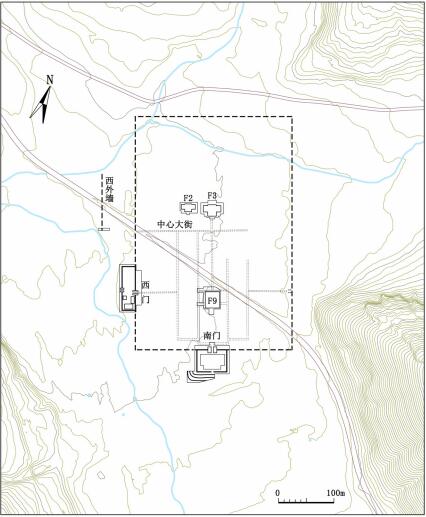
2017 excavation area plan
Archeological Discovery
South Wall, Gate and Barbican Entrance The south wall was in 2 meters wide and with 0.3 to 0.5 meters in ruined height. The south gate was a single gate with 4 meters in width, and two and steps, which were 6 meters in width and 10.6 meters in length on both west and east sides. There were bricks covering the outside of the steps, while now just base left, and inside each gate step there was a 1.4 to 1.6 meters block. Lots of semi-circular tiles and pan tiles, eaves tiles as well as Dishui (a kind of tile in the eave to help rain flow down). Outside the gate, there was a barbican entrance with 54 meters from west to east, 38.5 meters from north to south, and it was an external brickwork ( not constructed using clay and stone in the wall core). The gate of the barbican entrance was in the middle part of the south wall of itself, which lined up with the south gate, and it was also a single gate with 4.8 meters in width. There was a 5 meters wide trench, which was 7 meters away outside the barbican entrance.
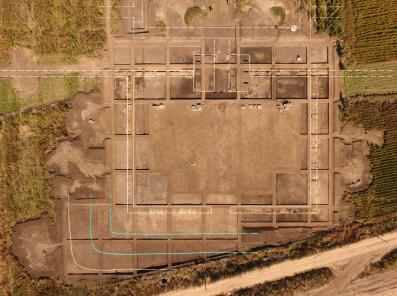
The South Wall, Gate and Barbican Entrance
West Interior Wall, West Gate and Barbican Entrance Through the excavation, the scale and building methods of west interior wall were basically the same with the north wall, without rammed earth left under the wall. The west gate located in the south of west interior wall, which was a 3 meters long single gate with gate steps on both side in 1.9 meters wide and 8.7 meters long. The barbican entrance was outside the west gate, 79 meters from north to south and 25.3 meters from east to west, with two courtyards in north and south. 2 house sites lined from south to north were discovered in the north courtyard, while 3 house sites were in south courtyard and 1 well in the southwest corner of the courtyard. 13 pieces of white glazed porcelain with “Shang Shi Ju (Imperial Cuisine)” mark were found inside the west barbican entrance.
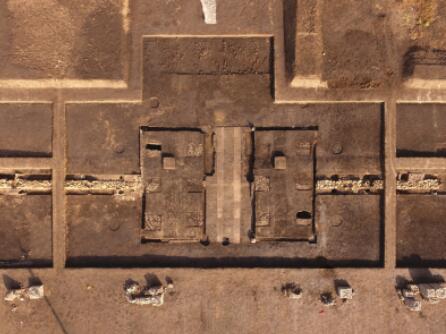
Aerial photo of the south gate
Building Remain No. 9 It was located in the north part of south gate, on the north-south central axis, towards south gate, and 75 meters away from it. According to the excavation, the building remain was three-room wide, and five rooms long, 29.2 meters from south to north, 26.2 meters from east to west with ruined 0.35 meters in height. Based on the analysis of structure and scale, it was the largest individual building with the biggest pedestal base and the highest building terrace, which should be the highest class among the building in the Prince Town.
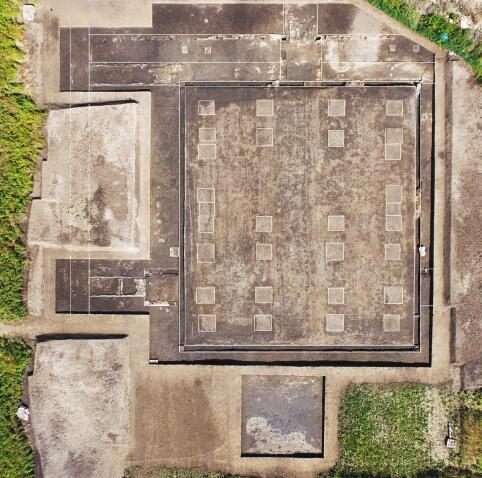
Building Remain No. 9
Building Remain No. 3 and No.2 Building No. 3 was in north of the middle part of the town, on the north-south central axis, layout as a cross, while the middle part was a three-room wide, and three-room deep with side halls on each side . Building No.2 was 13.3 meters away from No.3 Building, which is similar to No.3, but smaller than it. According to the exploration, Building No.1 was located on the west side of No. 2, both of them possess the similar structure and scale. There were walls around Building No. 1, 2 and 3, which separated them from other buildings in town, suggesting that the building complex consisting of building No.1, 2 and 3 were only less important than the individual building No. 9.
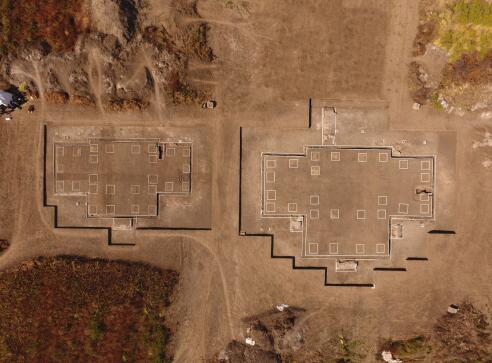
Building Remain No. 3 and No.2
The Assemblage
The relics of the Taizicheng Site were mainly kinds of clay semi-circular tiles and pan tiles, dragon and phoenix roof ridge decoration, kalavinka, as well as other building components. Besides, there were some green glazed semi-circular tiles and pan tiles and roof ridges, etc. Other than the building components, there unearthed some white glazed impressing and carving plates, black glazed chicken-leg shaped vase, and some broken pieces, as well as bronze animal head appliqué and doornails on wood building components. Among the components, there were lots of square bricks decorated with curved string, plain narrow bricks with marks as “Nei (Internal)”, “Gong (Palace)” and “Guan (Official)”, while 15 white glazed porcelains with impressed dragon fish pattern were marked “Shang Shi Ju”, together with 2 pieces of gilt bronze dragon head decoration. Based on the analysis of the unearthed relics, the time of the Taizicheng site belonged to late middle period of Jin Dynasty, which during the reigns of Emperor Shizong (1161-1189) and Emperor Zhangzong (1190-1208) in the Jin Dynasty.
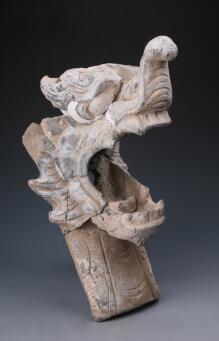
Dragon roof ridge decoration
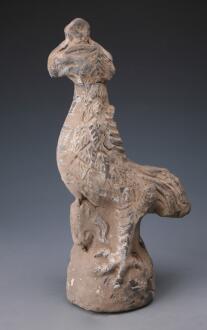
Phoenix roof ridge decoration
Academic Significance
The discovery of “Shang Shi Ju” mark porcelain Shang Shi Ju had been the place in charge of the “Tasting Imperial Cuisine”, and only white porcelains from Ding Kiln were discovered with “Shang Shi Ju” mark. The 15 porcelain with “Shang Shi Ju” mark in the Taizicheng Site was the archeological excavation unearthed largest number of “Shang Shi Ju” marked white porcelain besides Ding Kiln Site, which proved it belonged to royal property again.
The discovery of the bricks with “Nei (Internal)”, “Gong (Palace)” and “Guan (Official)” marks Lots of bricks with “Nei (Internal)”, “Gong (Palace)” and “Guan (Official)” marks were found,. Comparing with the royal exclusive wares with the marks of “Da Nei”, Upper Capital of Liao Dynasty and “Nei Fu” of Yuan and Ming Dynasties, it could be concluded that the bricks belonged to the same kind. The Taizicheng Site was the only palace site of late middle Jin Dynasty in Longguan County, therefore, it probably was the Tai He Palace for summer of Emperor Zhangzong, which was written in the book of The History of Jin(Jin Shi). (Translator: Lang Langtian Photo: Archaeology Press IA CASS)

2017 excavation area plan
Archeological Discovery
South Wall, Gate and Barbican Entrance The south wall was in 2 meters wide and with 0.3 to 0.5 meters in ruined height. The south gate was a single gate with 4 meters in width, and two and steps, which were 6 meters in width and 10.6 meters in length on both west and east sides. There were bricks covering the outside of the steps, while now just base left, and inside each gate step there was a 1.4 to 1.6 meters block. Lots of semi-circular tiles and pan tiles, eaves tiles as well as Dishui (a kind of tile in the eave to help rain flow down). Outside the gate, there was a barbican entrance with 54 meters from west to east, 38.5 meters from north to south, and it was an external brickwork ( not constructed using clay and stone in the wall core). The gate of the barbican entrance was in the middle part of the south wall of itself, which lined up with the south gate, and it was also a single gate with 4.8 meters in width. There was a 5 meters wide trench, which was 7 meters away outside the barbican entrance.

The South Wall, Gate and Barbican Entrance
West Interior Wall, West Gate and Barbican Entrance Through the excavation, the scale and building methods of west interior wall were basically the same with the north wall, without rammed earth left under the wall. The west gate located in the south of west interior wall, which was a 3 meters long single gate with gate steps on both side in 1.9 meters wide and 8.7 meters long. The barbican entrance was outside the west gate, 79 meters from north to south and 25.3 meters from east to west, with two courtyards in north and south. 2 house sites lined from south to north were discovered in the north courtyard, while 3 house sites were in south courtyard and 1 well in the southwest corner of the courtyard. 13 pieces of white glazed porcelain with “Shang Shi Ju (Imperial Cuisine)” mark were found inside the west barbican entrance.

Aerial photo of the south gate

Building Remain No. 9
Building Remain No. 3 and No.2 Building No. 3 was in north of the middle part of the town, on the north-south central axis, layout as a cross, while the middle part was a three-room wide, and three-room deep with side halls on each side . Building No.2 was 13.3 meters away from No.3 Building, which is similar to No.3, but smaller than it. According to the exploration, Building No.1 was located on the west side of No. 2, both of them possess the similar structure and scale. There were walls around Building No. 1, 2 and 3, which separated them from other buildings in town, suggesting that the building complex consisting of building No.1, 2 and 3 were only less important than the individual building No. 9.

Building Remain No. 3 and No.2
The Assemblage
The relics of the Taizicheng Site were mainly kinds of clay semi-circular tiles and pan tiles, dragon and phoenix roof ridge decoration, kalavinka, as well as other building components. Besides, there were some green glazed semi-circular tiles and pan tiles and roof ridges, etc. Other than the building components, there unearthed some white glazed impressing and carving plates, black glazed chicken-leg shaped vase, and some broken pieces, as well as bronze animal head appliqué and doornails on wood building components. Among the components, there were lots of square bricks decorated with curved string, plain narrow bricks with marks as “Nei (Internal)”, “Gong (Palace)” and “Guan (Official)”, while 15 white glazed porcelains with impressed dragon fish pattern were marked “Shang Shi Ju”, together with 2 pieces of gilt bronze dragon head decoration. Based on the analysis of the unearthed relics, the time of the Taizicheng site belonged to late middle period of Jin Dynasty, which during the reigns of Emperor Shizong (1161-1189) and Emperor Zhangzong (1190-1208) in the Jin Dynasty.

Dragon roof ridge decoration

Phoenix roof ridge decoration
Academic Significance
The discovery of “Shang Shi Ju” mark porcelain Shang Shi Ju had been the place in charge of the “Tasting Imperial Cuisine”, and only white porcelains from Ding Kiln were discovered with “Shang Shi Ju” mark. The 15 porcelain with “Shang Shi Ju” mark in the Taizicheng Site was the archeological excavation unearthed largest number of “Shang Shi Ju” marked white porcelain besides Ding Kiln Site, which proved it belonged to royal property again.
The discovery of the bricks with “Nei (Internal)”, “Gong (Palace)” and “Guan (Official)” marks Lots of bricks with “Nei (Internal)”, “Gong (Palace)” and “Guan (Official)” marks were found,. Comparing with the royal exclusive wares with the marks of “Da Nei”, Upper Capital of Liao Dynasty and “Nei Fu” of Yuan and Ming Dynasties, it could be concluded that the bricks belonged to the same kind. The Taizicheng Site was the only palace site of late middle Jin Dynasty in Longguan County, therefore, it probably was the Tai He Palace for summer of Emperor Zhangzong, which was written in the book of The History of Jin(Jin Shi). (Translator: Lang Langtian Photo: Archaeology Press IA CASS)
Category: English
News
Information
Key words:
